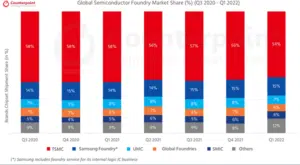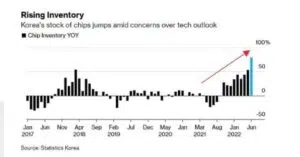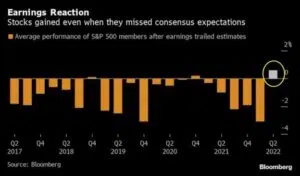Powered by Freedom Finance Broker – Learn more at the end of the article.
First, I would like to address an important point: you should not extrapolate current positive momentum into the future. The prominent American investor, Benjamin Graham, wrote about this when he referred to stocks of companies which have shown strong results (in terms of past earnings). I dare to extend this rule directly to stock performance. Trying to “predict” the reversal of individual stocks (in our case from the technology sector) based only on the performance of the last few weeks or technical analysis is not entirely correct.
Before deciding whether or not to buy a particular stock or ETF from the technology sector, there are several critical relevant factors to consider after assessing which decision to make:
Table of Contents
1 – It is Taiwan Semiconductor Manufacturing that holds the ‘lion’s share of semiconductor production.
In today’s reality, semiconductors are used almost everywhere. An uninterrupted supply of semiconductors is vital to national security. Disrupting the microelectronics supply chain could severely impact the US economy. A further escalation of the conflict between China and the US and an inability to export semiconductors from Taiwan could put severe pressure on technology companies. But on the other hand, stocks of semiconductors have been growing lately. Some companies (Samsung, Gartner) have already started forecasting a slowdown in semiconductor sales and a further decline in demand for smartphones and PCs. Let’s take semiconductor inventories in South Korea as an example:
Also, more recently, legislation has been passed to stimulate domestic semiconductor manufacturing in the US. The law provides $52.7 billion in subsidies for US semiconductor manufacturing and research and the US to better compete with China in the science and technology sector. The law also provides a 25% investment tax credit for chip plants, estimated at $24 billion.
The law would allocate $200 billion over ten years to stimulate scientific research in the US in order to better compete with China.
But you have to understand that the situation will not change abruptly overnight, and the risks associated with the relationship with China are not going anywhere.
2 – Recession with a likely scenario of stagflation.
An end to QT (monetary policy used by the central bank to reduce economic liquidity) is out of the question. Interest rates are still being raised. Paying current liabilities (e.g. mortgages) is becoming more and more difficult for the average American. Wealth is declining (around 42% of the wealth of Americans is in stocks and bonds). Committing even more to non-priority goods which rise in price (the producer “passes” the inflation on to the consumer) is not the best option. According to the law of demand, the higher the price of a good, the lower the demand for it. Thus, producers will adjust the production volume and, consequently, the supply. The consequence of these actions is likely to be weak reporting, which will already directly impact stock prices.
But, there is another side of the coin:
According to Bloomberg, this reporting season is characterised by unpredictability; US stocks are, on average, reacting quite positively to reports at or below expectations for the first time in many years.
3 – Fundamental analysis of the company and prospects for development.
It is worth assessing the company’s accounts and market share dynamics. The Balance Sheet and the Profit and Loss Statement deserve special attention, but it is worth paying attention to the Cash Flow Statement in terms of “cash flow from investing activities”. In addition, it is necessary to understand the management’s plans for the company’s development, what concepts they see and what steps they will take, as the technology sector is very dynamic and competitive.
In answer to the question “should we expect further growth?” it is worth clarifying: what length of time are we discussing here? A week, a month, a year, two years?
If we talk about short-term speculation, which is a matter of a few weeks, I would not expect any significant movements. If we are talking about a medium- or long-term investment, then it is time to start building and adding stocks to your watch list, identifying attractive securities and entry points for yourself in advance.
Powered by Freedom Finance Broker
Freedom Finance Broker is the only EU broker for buying new stocks at their initial (IPO) price with 53%* average stock price growth in 3 months.
Join Freedom Finance Broker right now to trade stocks, ETFs and US options at affordable prices.
Build your portfolio 100% commission free in the first 30 days after registration with the link below.
>OPEN YOUR FREE FREEDOM FINANCE BROKER ACCOUNT HERE<
*as of 17.08.2022 .
Investments in securities and other financial instruments always involve the risk of loss of your capital. Buying stocks at IPO prices may involve additional restrictions. The forecast or past performance is no guarantee of future results.


















Recent Comments